The crypto market collapsed again. Why is it so tragic in Q1 2025?

Reprinted from panewslab
03/31/2025·1MAuthor: Luke, Mars Finance
At the end of March 2025, the global financial market experienced a severe turmoil. The U.S. stock market encountered a "Black Friday" on March 28, with the S&P 500 falling 1.97%, the Nasdaq plummeting 2.7%, and the Dow Jones Industrial Average falling 715 points, a drop of 1.69%. The decline quickly affected the cryptocurrency market, with Bitcoin (BTC) falling from $84,000 on the afternoon of March 29 to $81,565 on the morning of March 31, Ethereum (ETH) falling to a recent low of $1,767, and Solana (SOL) hitting a low of $122.68 on March 30 at 18:00 on March 30.
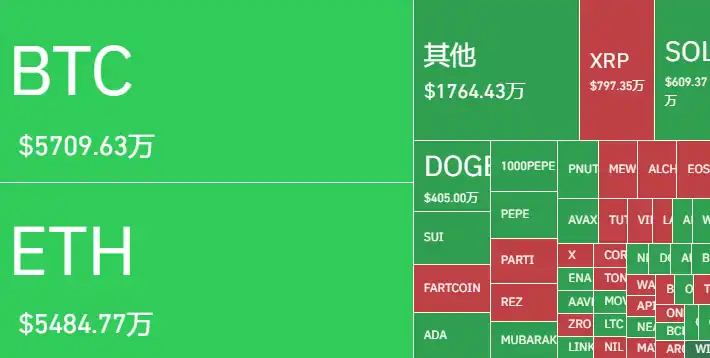
According to Coinglass data, about 70,000 cryptocurrency investors have lost their positions in the past 48 hours, losing about $200 million. This cross-market chain reaction not only triggered widespread panic, but also exposed the vulnerability of the current economic environment. This article will combine the views of multiple authoritative institutions to deeply analyze the causes of this plunge, and explore the key events and potential impacts that investors should pay attention to this week.
The whole story of the plunge: the chain effect from Black Friday to
crypto weekend
Key nodes and data
The plunge in U.S. stocks began on "Black Friday" on March 28. According to Investopedia, the S&P 500 fell 112.37 points to 5,580.94 points, the Nasdaq fell 481.04 points to 17,322.99 points, and the Dow Jones Industrial Average fell 715.80 points to 41,583.90 points. Technology stocks led the decline, with the market value of the seven major technology giants (including Apple, Microsoft, Amazon, etc.) evaporating about US$505 billion, and the Philadelphia Semiconductor Index fell by 2.95%. This is the largest single-day decline since the U.S. stock crash on March 10, marking a drastic adjustment at the end of the first quarter of 2025.
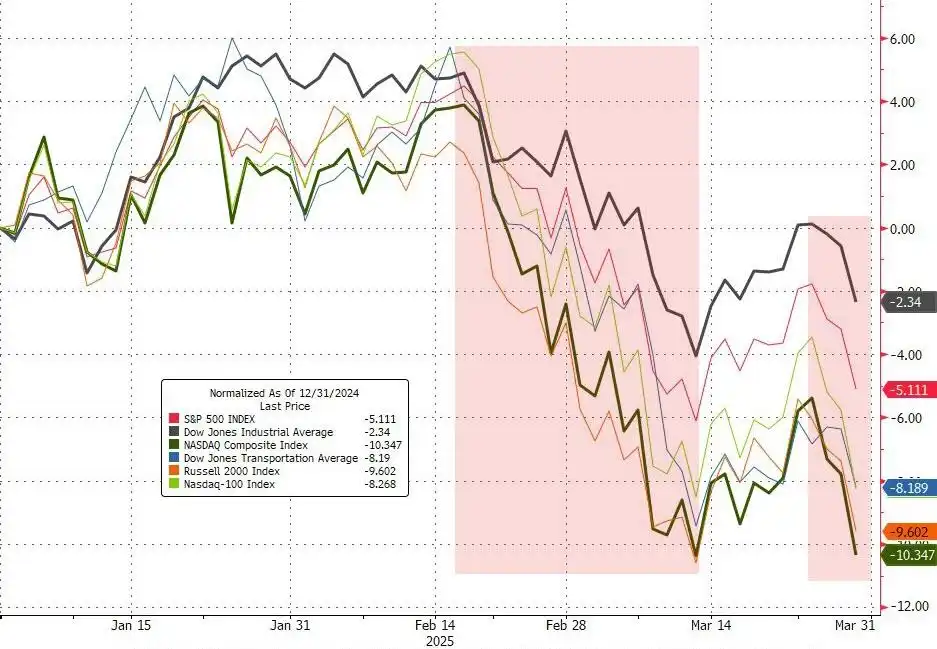
The cryptocurrency market is under pressure. Bitcoin fell 8 hours to $81,644 at 84,000 on March 29, a drop of more than 3%, and then rebounded to $83,536 at 18:00 on March 30, but failed to hold on to the rally and fell to $81,565 at 6:00 on March 31. Ethereum fell to $1,767 and Solana fell to $122.68. According to The Block data, the total market value of cryptocurrencies fell from its peak of $3.9 trillion to $2.9 trillion, a drop of 25%, and trading volume fell from $126 billion after the November 5 election to $35 billion, shrinking by about 70%.
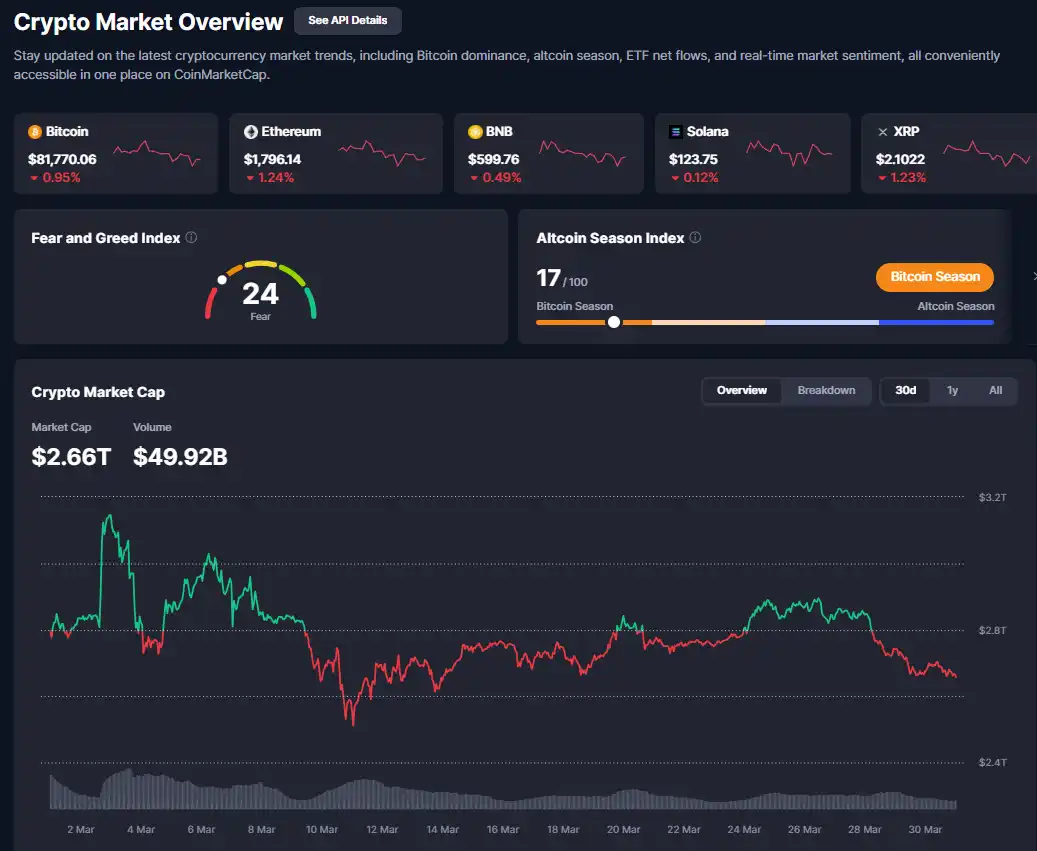
Market sentiment and capital flow
The simultaneous decline in U.S. stocks and crypto markets reflects the rising risk aversion sentiment of investors towards risky assets. Galaxy Research pointed out that Bitcoin and technology stocks are clearly linked. During this decline, crypto-related stocks such as MicroStrategy (MSTR) plummeted 10% on Friday, and Coinbase Global (COIN) fell more than 6%, indicating that panic spread rapidly. InvestingHaven analyst Taki Tsaklanos believes that Bitcoin’s short-term support is at $77,000, and a loss may trigger a larger liquidation.
Inducement of plunge: Multiple factors intertwined to impact the market
**Macroeconomic pressure, inflation exceeds expectations and consumer
confidence decline**
The US Department of Commerce's core PCE price index for February released on March 28 showed that it increased by 0.4% month-on-month and 2.8% year-on-year, both higher than market expectations of 0.3% and 2.6%. Goldman Sachs pointed out in its March 31 research report that this data shows that inflationary pressure is tenacious, which may push up core PCE to 3.5%, and lower GDP growth forecasts in 2025 from 1.5% to 1.0%, and the probability of an economic recession rises from 20% to 35%. The University of Michigan Consumer Confidence Index fell to 57, the lowest since 2022, with consumer inflation expectations rising to 5% for the coming year and 4.1% for the five-year forecast, both decades highs.
The statements of the Federal Reserve's voting committee have exacerbated market concerns. Boston Fed Chairman Collins said it was "it's appropriate to maintain high interest rates longer", while Richmond Fed Chairman warned that tariffs could have "more lasting inflation shock." Goldman Sachs analysts believe that inflation exceeds expectations weakens expectations for interest rate cuts, and capital flows to safe-haven assets have become an important driver of market decline.
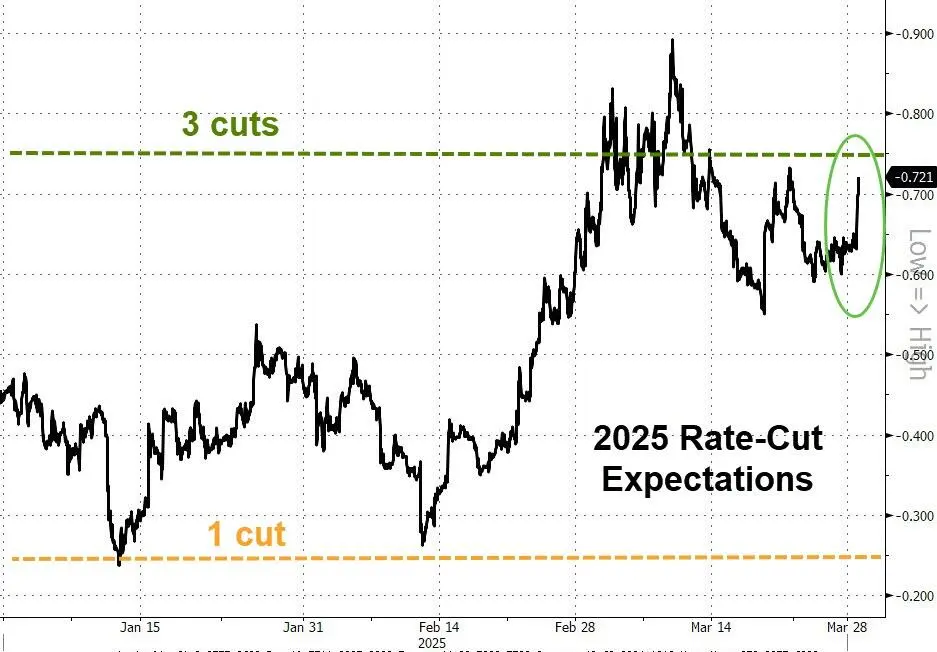
Policy uncertainty, fear caused by Trump's tariff measures
The Trump administration plans to announce the "peer-to-peer tariff" policy on April 2 is the core catalyst for the plunge. Goldman Sachs expects tariffs to be imposed on all trading partners by an average of 15%, a 5 percentage point increase from previous expectations, which could push up import costs and trigger global retaliation. Matthew Aks, senior strategist at Evercore ISI, warned that “If retaliation is taken by other countries, it may trigger the risk of tariff escalation and further weaken market confidence.” Michael Arone, chief investment strategist at State Street Global Advisors, noted that “uncertainty continues to plague the market and may be the peak of volatility next week.”
Investopedia quoted experts as saying that tariff policies not only boost inflation expectations, but also may weaken corporate profitability and consumption capacity, especially on the technology and automobile industries. "When major events approach, investors tend to avoid risks, resulting in an intensified weekend sell-off," said Jay Woods, chief global strategist at Freedom Capital Markets. "BTC is more like tech stocks than safe-haven assets due to external funds from ETFs."
Money flow and market linkage
The "Black Friday" of US stocks triggered a chain reaction of risky assets. According to Nasdaq data, the correlation between the Nasdaq index and Bitcoin reached 0.67 at the beginning of 2025, and its 2.7% decline was quickly transmitted to the crypto market. Bloomberg commodity strategist Mike McGlone analyzed, "If the S&P 500 continues to be weak, Ethereum may fall to $1,000 and Bitcoin may fall to $72,000." Gold prices hit a new high, with the U.S. 10-year Treasury yield falling from 4.369% on Thursday to 4.254% on Friday, indicating accelerated flow of funds to safe-haven assets. Crypto-related stocks such as MicroStrategy fell 11% at one time, while MARA Holdings fell 11%.
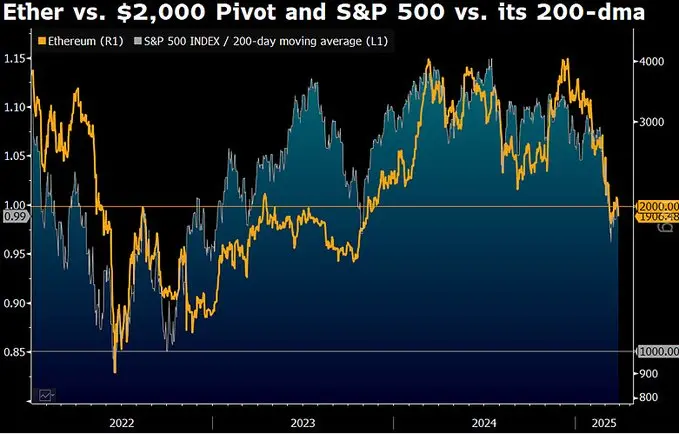
The Block pointed out that the rebalancing of funds at the end of the quarter combined with next week's "super risk week" (April 2 tariff announcement and April 5 non-agricultural data) has prompted investors to adjust their positions and hedge ahead of schedule, and funds shift from risky assets to gold and U.S. bonds. Galaxy Research analyst Alex Thorn believes that "a shrinking trading volume may indicate greater volatility in the future, and the reduction in liquidity will amplify the price impact."
Intrinsic risks of the market: leverage and trading volume shrink
InvestingHaven predicts that if Bitcoin falls below $77,000, it may trigger a long liquidation of about $300 million, further exacerbating the decline. According to The Block, trading volume fell from its peak of $126 billion to $35 billion, indicating that market participants may be waiting for clear regulation and lack of buying support in the short term.
Events that investors should pay attention to this week
As the market enters early April, investors need to pay close attention to the following key events that may further affect the trends of the U.S. stock and crypto markets:
· April 2 (Tuesday): Overview of Trump's "reciprocal tariffs" policy announcement: The Trump administration plans to announce an average tariff policy of 15% on all trading partners. Goldman Sachs expects the move to drive up import costs and could trigger global retaliatory tariffs. If tariff measures are as severe as expected, US stocks may fall 3%-5%, and Bitcoin may fall below the $80,000 support level; if the policy intensity is lower than expected (such as excluding semiconductor and automotive industries), the market may usher in a brief rebound, and Bitcoin is expected to rebound to $85,000. Matthew Aks of Evercore ISI noted that “market response will depend on the timing of tariffs and the target industry.”
· Wednesday, April 3: Minutes of the ECB’s March Monetary Policy Meeting Release Overview of Events: The ECB will release minutes of its March meeting, which may reveal the latest assessment of the euro zone economy and inflation and whether to speed up the pace of interest rate cuts. If the minutes show dovish tendencies (such as further rate cuts), it may boost global risk assets, and the crypto market may follow the rebound of US stocks; if the prudent stance is maintained, it may intensify risk aversion and suppress Bitcoin and Ethereum prices. Michael Arone of State Street believes that “the ECB’s policy direction will affect global liquidity expectations.”
· April 4 (Thursday): Overview of the speech by Federal Reserve Chairman Powell: Powell will speak on U.S. economic and monetary policy, possibly responding to inflation data and tariff impacts. If Powell sends out a signal of a rate cut (such as responding to the slowdown), U.S. stocks and crypto markets may rise 2%-3%, and Bitcoin may exceed $83,000; if it emphasizes maintaining high interest rates, it may intensify selling pressure. Bloomberg analyst Mike McGlone warned, "Powell's tone will directly affect the short-term trend of risky assets."
· April 5 (Friday): Overview of events released by the U.S. non-farm employment report: March non-farm employment data will reveal the health of the U.S. labor market, with the market expecting new jobs to be less than 200,000, and the unemployment rate may rise to 4.2%. If the data is weak (new jobs are less than 150,000), it will strengthen the expectation of interest rate cuts, which will be beneficial to the US stock market and crypto markets, and Bitcoin may rebound to US$86,000; if the data exceeds expectations, it may push up US Treasury yields and suppress risky assets. Goldman Sachs expects "non-farm data will be the climax of market volatility this week."
· April 5 (Friday): Overview of Microsoft's 50th anniversary and Copilot update events: Microsoft will celebrate its 50th anniversary and may announce major updates to AI assistant Copilot. If the update exceeds expectations, it may boost confidence in technology stocks. The Nasdaq index may rise by 1%-2%, indirectly driving crypto market sentiment; if the update is dull, the impact will be limited. Taki Tsaklanos of InvestingHaven believes that “the performance of tech stocks will provide a vane for the crypto market.”
Institutional Perspectives and Market Outlook
Goldman Sachs: Risk of recession rises
Goldman Sachs significantly raised its tariff forecast for 2025 in its research report on March 31, with an expected average tariff rate rising by 15 percentage points, core PCE inflation rose to 3.5%, GDP growth slowed to 1.0%, and unemployment climbed to 4.5% at the end of the year. The bank raises the probability of a recession to 35% within 12 months and expects the Federal Reserve to cut interest rates three times in the second half of the year to cope with growth pressures. Goldman Sachs analysts pointed out that "consumers and businesses are weak, the economy is entering a fragile stage, and the impact of policy risks is greater than in recent years."
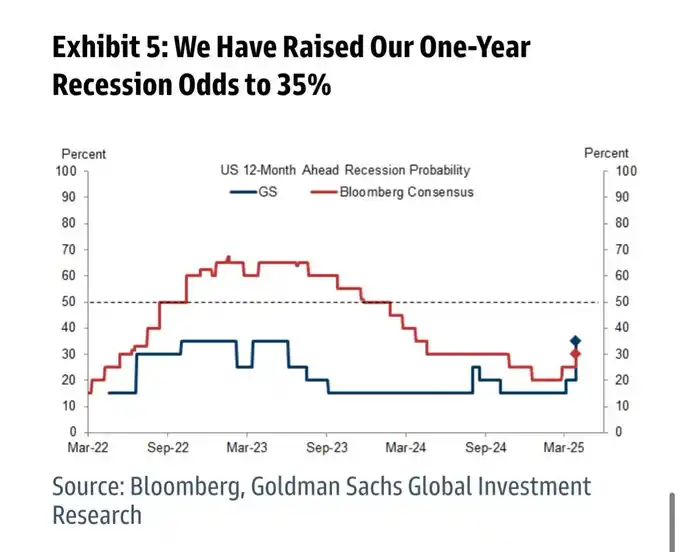
Galaxy Research: The crypto market still has potential
Galaxy Research predicts that Bitcoin may reach $185,000 in 2025 and Ethereum exceeds $5,500, provided that regulatory environment improves and institutional adoption deepens. Analyst Alex Thorn believes that "short-term volatility is inevitable, but in the long run, Bitcoin will surpass the S&P 500 and gold." The institution also expects that the asset management scale of US Bitcoin ETFs will exceed US$250 billion by the end of 2025.
InvestingHaven: Technical support and risk coexist
InvestingHaven analyst Taki Tsaklanos said that Bitcoin’s long-term bullish pattern has not changed, with $77,000 being the key support level, and if held, it may rebound in May. But if it falls below, it may test $70,000. Analysts warn, "The market needs to respect the 50% Fibonacci retracement level, otherwise bullish expectations will expire."
Bloomberg and Evercore ISI: Short-term volatility intensifies
Bloomberg strategist Mike McGlone believes that "Bitcoin's high correlation with the Nasdaq 100 makes it more like a high beta asset and may follow the U.S. stock market further downward in the short term." Matthew Aks of Evercore ISI pointed out that "the tariff statement on April 2 is an important milestone, but the uncertainty will not be eliminated at once, and the market needs to be wary of the ripple of retaliatory tariffs."
Summary and future trends
The "Black Friday" and the cryptocurrency weekend plunge are the result of the combined effect of macroeconomic pressure, policy uncertainty, capital flows and market inherent risks. In the short term, the announcement of tariff policies on April 2 will be a key turning point. If the measures are severe and trigger global trade frictions, Bitcoin may fall below $80,000, and U.S. stocks may fall further. However, Goldman Sachs’ expected rate cut and institutional adoption mentioned by Galaxy Research may inject rebound momentum into the market.


 chaincatcher
chaincatcher